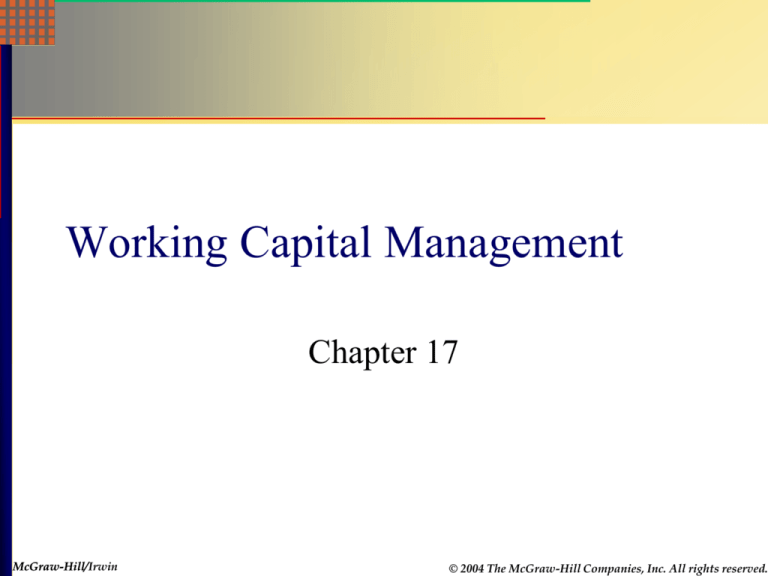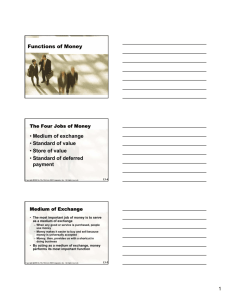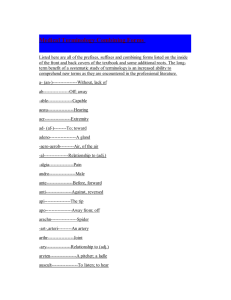
Working Capital Management
Chapter 17
McGraw-Hill
McGraw-Hill/Irwin
© 2004 The McGraw-Hill Companies, Inc. All rights reserved.
Key Concepts and Skills
Understand
how firms manage cash and various
collection, concentration and disbursement
techniques
Understand how to manage receivables and the
basic components of credit policy
Understand various inventory types, different
inventory management systems and what
determines the optimal inventory level
17.1
McGraw-Hill
McGraw-Hill/Irwin
© 2004 The McGraw-Hill Companies, Inc. All rights reserved.
Chapter Outline
Float
and Cash Management
Cash Management: Collection, Disbursement,
and Investment
Credit and Receivables
Inventory Management
Inventory Management Techniques
17.2
McGraw-Hill
McGraw-Hill/Irwin
© 2004 The McGraw-Hill Companies, Inc. All rights reserved.
Reasons for Holding Cash
Speculative motive – hold cash to take advantage of
unexpected opportunities
Precautionary motive – hold cash in case of emergencies
Transaction motive – hold cash to pay the day-to-day
bills
Trade-off between opportunity cost of holding cash
relative to the transaction cost of converting marketable
securities to cash for transactions
17.3
McGraw-Hill
McGraw-Hill/Irwin
© 2004 The McGraw-Hill Companies, Inc. All rights reserved.
Understanding Float
Float – difference between cash balance recorded in the
cash account and the cash balance recorded at the bank
Disbursement float
Generated when a firm writes checks
Available balance at bank – book balance > 0
Collection float
Checks received increase book balance before the bank
credits the account
Available balance at bank – book balance < 0
Net float = disbursement float + collection float
17.4
McGraw-Hill
McGraw-Hill/Irwin
© 2004 The McGraw-Hill Companies, Inc. All rights reserved.
Example: Types of Float
You
have $3000 in your checking account.
You just deposited $2000 and wrote a check
for $2500.
What is the disbursement float?
What is the collection float?
What is the net float?
What is your book balance?
What is your available balance?
17.5
McGraw-Hill
McGraw-Hill/Irwin
© 2004 The McGraw-Hill Companies, Inc. All rights reserved.
Cash Collection
Payment
Mailed
Payment
Received
Mailing Time
Payment
Deposited
Processing Delay
Cash
Available
Availability Delay
Collection Delay
One of the goals of float management is to try and reduce the
collection delay. There are several techniques that can reduce
various parts of the delay.
17.6
McGraw-Hill
McGraw-Hill/Irwin
© 2004 The McGraw-Hill Companies, Inc. All rights reserved.
Cash Disbursements
Slowing
down payments can increase
disbursement float – but it may not be ethical or
optimal to do this
Controlling disbursements
Zero-balance account
Controlled disbursement account
17.7
McGraw-Hill
McGraw-Hill/Irwin
© 2004 The McGraw-Hill Companies, Inc. All rights reserved.
Investing Cash
market – financial instruments with an
original maturity of one-year or less
Temporary Cash Surpluses
Money
Seasonal or cyclical activities – buy marketable
securities with seasonal surpluses, convert securities
back to cash when deficits occur
Planned or possible expenditures – accumulate
marketable securities in anticipation of upcoming
expenses
17.8
McGraw-Hill
McGraw-Hill/Irwin
© 2004 The McGraw-Hill Companies, Inc. All rights reserved.
Figure 17.4
17.9
McGraw-Hill
McGraw-Hill/Irwin
© 2004 The McGraw-Hill Companies, Inc. All rights reserved.
Characteristics of Short-Term
Securities
– firms often limit the maturity of shortterm investments to 90 days to avoid loss of
principal due to changing interest rates
Default risk – avoid investing in marketable
securities with significant default risk
Marketability – ease of converting to cash
Taxability – consider different tax characteristics
when making a decision
Maturity
17.10
McGraw-Hill
McGraw-Hill/Irwin
© 2004 The McGraw-Hill Companies, Inc. All rights reserved.
Credit Management: Key Issues
Granting
credit increases sales
Costs of granting credit
Chance that customers won’t pay
Financing receivables
Credit
management examines the trade-off
between increased sales and the costs of granting
credit
17.11
McGraw-Hill
McGraw-Hill/Irwin
© 2004 The McGraw-Hill Companies, Inc. All rights reserved.
The Cash Flows from Granting
Credit
Credit Sale
Check Mailed
Check Deposited
Cash Available
Cash Collection
Accounts Receivable
17.12
McGraw-Hill
McGraw-Hill/Irwin
© 2004 The McGraw-Hill Companies, Inc. All rights reserved.
Components of Credit Policy
Terms
of sale
Credit period
Cash discount and discount period
Type of credit instrument
analysis – distinguishing between “good”
customers that will pay and “bad” customers that
will default
Collection policy – effort expended on collecting
on receivables
Credit
17.13
McGraw-Hill
McGraw-Hill/Irwin
© 2004 The McGraw-Hill Companies, Inc. All rights reserved.
Terms of Sale
Basic
Form: 2/10 net 45
2% discount if paid in 10 days
Total amount due in 45 days if discount not taken
Buy
$500 worth of merchandise with the credit
terms given above
Pay $500(1 - .02) = $490 if you pay in 10 days
Pay $500 if you pay in 45 days
17.14
McGraw-Hill
McGraw-Hill/Irwin
© 2004 The McGraw-Hill Companies, Inc. All rights reserved.
Example: Cash Discounts
Finding the implied interest rate when customers do not
take the discount
Credit terms of 2/10 net 45 and $500 loan
$10 interest (.02*500)
Period rate = 10 / 490 = 2.0408%
Period = (45 – 10) = 35 days
365 / 35 = 10.4286 periods per year
EAR = (1.020408)10.4286 – 1 = 23.45%
The company benefits when customers choose to forego
discounts
17.15
McGraw-Hill
McGraw-Hill/Irwin
© 2004 The McGraw-Hill Companies, Inc. All rights reserved.
The Cost of Granting Credit
Cost
($)
Optimal
amount of
credit
Carrying Cost
Opportunity costs
Amount of credit
extended ($)
17.16
McGraw-Hill
McGraw-Hill/Irwin
© 2004 The McGraw-Hill Companies, Inc. All rights reserved.
Credit Analysis
Process of deciding which customers receive credit
Gathering information
Financial statements
Credit reports
Banks
Payment history with the firm
Determining Creditworthiness
5 Cs of Credit
Credit Scoring
17.17
McGraw-Hill
McGraw-Hill/Irwin
© 2004 The McGraw-Hill Companies, Inc. All rights reserved.
Five Cs of Credit
– willingness to meet financial
obligations
Capacity – ability to meet financial obligations
out of operating cash flows
Capital – financial reserves
Collateral – assets pledged as security
Conditions – general economic conditions related
to customer’s business
Character
17.18
McGraw-Hill
McGraw-Hill/Irwin
© 2004 The McGraw-Hill Companies, Inc. All rights reserved.
Collection Policy
Monitoring
receivables
Keep an eye on average collection period relative to
your credit terms
Use an aging schedule to determine percentage of
payments that are being made late
Collection
policy
Delinquency letter
Telephone call
Collection agency
Legal action
17.19
McGraw-Hill
McGraw-Hill/Irwin
© 2004 The McGraw-Hill Companies, Inc. All rights reserved.
Inventory Management
Inventory
can be a large percentage of a firm’s
assets
Costs associated with carrying too much
inventory
Costs associated with not carrying enough
inventory
Inventory management tries to find the optimal
trade-off between carrying too much inventory
versus not enough
17.20
McGraw-Hill
McGraw-Hill/Irwin
© 2004 The McGraw-Hill Companies, Inc. All rights reserved.
Types of Inventory
Manufacturing
firm
Raw material – starting point in production process
Work-in-progress
Finished goods – products ready to ship or sell
Remember
that one firm’s “raw material” may be
another company’s “finished good”
Different types of inventory can vary
dramatically in terms of liquidity
17.21
McGraw-Hill
McGraw-Hill/Irwin
© 2004 The McGraw-Hill Companies, Inc. All rights reserved.
Inventory Costs
Carrying costs – range from 20 – 40% of inventory value
per year
Storage and tracking
Insurance and taxes
Losses due to obsolescence, deterioration or theft
Opportunity cost of capital
Shortage costs
Restocking costs
Lost sales or lost customers
Consider both types of costs and minimize the total cost
17.22
McGraw-Hill
McGraw-Hill/Irwin
© 2004 The McGraw-Hill Companies, Inc. All rights reserved.
Inventory Management
Classify
inventory by cost, demand and need
Those items that have substantial shortage costs
should be maintained in larger quantities than
those with lower shortage costs
Generally maintain smaller quantities of
expensive items
Maintain a substantial supply of less expensive
basic materials
17.23
McGraw-Hill
McGraw-Hill/Irwin
© 2004 The McGraw-Hill Companies, Inc. All rights reserved.
EOQ Model
The EOQ model minimizes the total inventory cost
Total carrying cost = (average inventory) x (carrying
cost per unit) = (Q/2)(CC)
Total restocking cost = (fixed cost per order) x (number
of orders) = F(T/Q)
Total Cost = Total carrying cost + total restocking cost =
(Q/2)(CC) + F(T/Q)
Q
*
2TF
CC
17.24
McGraw-Hill
McGraw-Hill/Irwin
© 2004 The McGraw-Hill Companies, Inc. All rights reserved.
Example: EOQ
Consider
an inventory item that has carrying cost
= $1.50 per unit. The fixed order cost is $50 per
order and the firm sells 100,000 units per year.
What is the economic order quantity?
2(100,000)(50)
Q
2582
1.50
*
17.25
McGraw-Hill
McGraw-Hill/Irwin
© 2004 The McGraw-Hill Companies, Inc. All rights reserved.
Extensions
Safety
stocks
Minimum level of inventory kept on hand
Increases carrying costs
Reorder
points
At what inventory level should you place an order?
Need to account for delivery time
Derived-Demand
Inventories
Materials Requirements Planning (MRP)
Just-in-Time Inventory
17.26
McGraw-Hill
McGraw-Hill/Irwin
© 2004 The McGraw-Hill Companies, Inc. All rights reserved.
Quick Quiz
What
is the difference between disbursement
float and collection float?
What is credit analysis and why is it important?
What is the implied rate of interest if credit terms
are 1/5 net 30?
What are the two main categories of inventory
costs?
What components are required to determine the
economic order quantity?
17.27
McGraw-Hill
McGraw-Hill/Irwin
© 2004 The McGraw-Hill Companies, Inc. All rights reserved.









